
Pioneer Texas archeologist Alex
Krieger defined the cultural pattern known as the Henrietta
focus, drawing heavily on evidence from the Harrell
site. Photo from TARL Archives.
Click images to enlarge
|
|
Reconstructing the history of the part of the Brazos
on which the Harrell site is located is like trying
to visualize a motion picture on the basis of a few
still photographs. Jack Hughes, 1942.
|
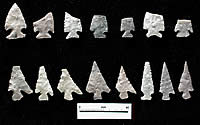
Arrowpoints, including several of
the expanding stem Scallorn points found in the burials.
|
|
Today we realize that the archeological evidence
from the Harrell site is much more complex than the
archeologists of the 1930s and 1940s recognized and
that some of its cultural debris accumulated long before
the Plains Villager era.
|
| |
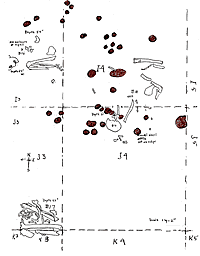
Fox recorded a series of soil stains
as possible post holes. Lacking further information,
we can only speculate as to the accuracy of the interpretation
and what they might represent. In this drawing, we have
superimposed the stains over the positions of the burials
in the area.
|
|
Stepping back in time, we see the transition between
Late Prehistoric I and Late Prehistoric II (the Plains
Village era) was a time of upheaval and extreme violence.
|
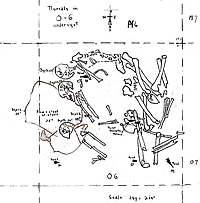
A 1938 field drawing of a multiple
burial (27-29) records the close position of the individuals
and the arrow points which likely killed them. Adapted
from Fox, 1938; TARL Archives.
|
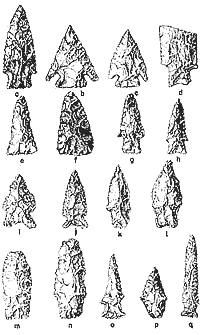
The variety of dart points found
at the Harrell site suggests the site was used by prehistoric
peoples for several thousand years before the Plains
Village groups came to the spot. Drawing from Krieger,
1947.
|
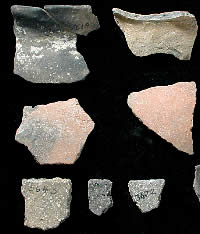
Sherds of shell-tempered Nocona Plain
pottery are diagnostic of Plains Villager groups and
the Henrietta focus.
|
| |
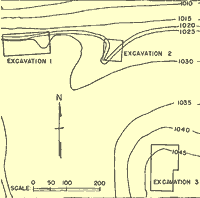
Contour map of the Harrell site,
showing high terrace location of the main habitation
area investigated in Excavation 3. Map from TARL Archives.
|
|
From the present vantage point we can see that
the archeologists of the 1940s misunderstood several key aspects
of the Harrell site. The critical problem is that they did
not have any way to accurately gauge the age of the deposits.
Radiocarbon dating was not developed as a research tool until
the 1950s. And only in the last few decades have modern geological
methods been applied routinely in archeological investigations.
Without these two critical research tools, it is hardly surprising
that the Harrell site was seen by archeologist Alex Krieger
as representing a single culture which he called the Henrietta
Focus.
Alex Krieger was trying to make sense of extremely
broad cultural patterns and link the chronology or time line
of the poorly dated moundbuilding cultures of the southeastern
United States with that of the tree-ring-dated Puebloan cultures
of the southwest. He used the Harrell site and the Henrietta
focus to do just that by arguing that the Plains Villagers
of north Texas were contemporaneous with late Puebloan peoples
and late Caddoan groups. In a general sense, this view has
been borne out by a great deal of research over the last 65
years. But modern researchers have also learned many things
that enable us to reevaluate the dating of the Harrell site.
Krieger argued that the Henrietta Focus dated
to A.D. 1450-1650 based on the relative dates of several Southwestern
pottery sherds and at least one Caddo sherd that were found
at the Harrell site. From the fact that the site's distinctive
shell-tempered pottery (which he named Nocona Plain) was found
in both the midden and in the underlying red clay, Krieger
concluded that the entire 8- to 10-foot thick artifact-bearing
deposit in Excavation 3 could have formed in as little as
two hundred years, mainly as the result of the periodic addition
of flood deposits. He, like Jack Hughes, recognized that certain
of the dart points were more characteristic of central Texas,
where they were regarded as comparatively early artifact styles
that dated to the Archaic period before the introduction of
the bow and arrow. But Krieger assumed that the presence of
these styles at Harrell along with arrow points and pottery
in the same deposit meant that these dart point styles continued
to be used by latter peoples. In contrast, Hughes correctly
reasoned that earlier central-Texas-related peoples had lived
at the Harrell site before the later Plains-related peoples
who used the bow and arrow and made pottery. Hughes' views
were stated cautiously in his unpublished Master's thesis
and were soon overshadowed by Krieger's grand synthesis.
Today we have a much better understanding of
chronology. The earliest distinctive artifacts found at the
Harrell site are the beveled-stem Nolan dart points now known
to date to the Middle Archaic period about 4500-5000 years
ago (2500-3000 B.C.). Also found among the Harrell site's
artifacts are examples of Pedernales, Bulverde, Castroville,
Marcos, Ensor, Fairland and Darl dart points (among others),
indicating that the site was occupied intermittently during
much of the Late Archaic, roughly 1200 to 4500 years ago (2500
B.C. to A.D. 800).
Nonetheless, most of the artifacts at the Harrell
site do date to the Late Prehistoric era, between about A.D.
800 and A.D. 1500. According to Hughes, some 555 arrow points
were recovered from the site compared to only 81 dart points.
All of the almost 600 pottery sherds also date to the Late
Prehistoric, probably after A.D. 1200. In other words, the
site's major occupation period was after A.D. 800.
From the present perspective, we guess that
the third or high terrace where most of the Harrell site excavations
were carried out probably existed as a more or less stable
landform by about 5000 years ago (roughly 3000 B.C.). We further
surmise that during the subsequent 4500 years (from about
3000 B.C. to A.D. 1500) a maximum of five feet of sediment
accumulated on the terrace top. As Hughes realized, by far
the bulk of all the artifacts occurred in the upper five feet
in the dark midden soil as well as all 135 hearths and all
32 graves. The only things found deeper were relatively small
quantities of scattered artifacts, some of which were found
within the apparent pits that intruded into the underlying
red clay. Whereas Krieger assumed that river floods continued
to add sediment to the upper terrace while it was occupied,
we doubt this was the case to any significant degree during
the Late Prehistoric era. The midden layer is clearly what
archeologists today call an anthrosol (literally "man-soil").
That is to say that the refuse, artifacts, hearth rocks and
so on that people hauled to and left on the Harrell site were
mixed in with the existing soil resulting in a distinct cultural
layer.
We suspect that the Middle and Late Archaic
materials were buried fairly quickly and may have been neatly
stratified in a "layer-cake" fashion. However, after
A.D. 800 or so, the site was used more intensively by a series
of Late Prehistoric peoples, including the Plains Villagers
who were responsible for the bulk of the debris and midden
accumulation. There is obvious evidence that the Late Prehistoric
occupants were habitually digging holes—pits for hearths,
graves, and probably for houses and storage. These actions
intruded into and greatly disturbed the earlier (Archaic)
layers.
While no obvious evidence of houses or structures
was recognized, there were several tantalizing clues. Excavators
noticed two odd features in the southeast section of the excavation
block, in the area of Burial 31. One was an area of fire-burned
red clay with impressions of grass and twig marks. Fox noted
that it "appears a fireplace but looks like wattle work."
In the unit just north, he recorded an oval of cemented white
ashes with two cut depressions in the interior. Whether these
features pertained to a house (with wattle and twigs) with
an interior hearth is unknown; no further mention of the features
was made in subsequent analyses. At the north end of the cemetery,
Fox also recorded a number of possible post-hole stains in
the area of several graves holding very incomplete skeletal
remains. The stains were in groups or clusters, and several
appeared to align in rough arcs. These may represent the supports
for some sort of arbor-like mortuary structures similar to
those recognized at Zimms Complex sites in northwestern Oklahoma.
Nonetheless, houses and other types of structures
were almost certainly built at the Harrell site and probably
placed in shallow pits like those that have been documented
at many other Plains Villager sites. All this digging and
earth moving coupled with the continuous burrowing of rodents
(of which much evidence was seen) resulted in the site deposits
becoming badly mixed through time. While the overall trends
are clear—most of the dart points were more deeply buried
than most of the potsherds—the mixing makes it impossible
to neatly sort out the site into separate time periods. The
only things at the Harrell site that we can confidently date
are those that have been dated elsewhere.
Age of the Cemetery
Before attempting a trial reconstruction of
the human history of the Harrell site, we must raise a thorny
dating problem that cannot be satisfactorily resolved without
further research. That is the age of the cemetery. Krieger
and Hughes both assumed that the graves dated to the latest
and main period of site occupation. In broad terms this is
undoubtedly true: the graves are Late Prehistoric in age.
But today we recognize that the Late Prehistoric era spans
at least 700-800 years and probably 1,000 or more. The bow
and arrow may have been introduced into the southern and central
Plains before the time of Christ followed by the introduction
of cord-marked pottery during the first centuries A.D. These
technologies are the hallmarks of the Late Prehistoric era.
The early part of the Late Prehistoric (sometimes
called Late Prehistoric I), from perhaps A.D. 500 or so to
A.D. 1100-1300 is seen by most experts as a time of change
during which the hunting and gathering traditions that characterize
the long archaic era were gradually altered by the introduction
of a new weapon system (the bow and arrow), new storage and
cooking technology (pottery), and, even more importantly,
agriculture and semi-sedentary life. Some areas, such as most
of the Edwards Plateau in central Texas, continued to be occupied
by purely hunting and gathering cultures at the same time
that more-settled village life was becoming prevalent elsewhere.
By the later part of the Late Prehistoric (sometimes
called Late Prehistoric II), after A.D. 1200-1250, settled
villagers lived along virtually all of the river valleys of
the southern Plains. Most sites show evidence of corn farming
along with heavy reliance on buffalo hunting, a mixed economy
that sustained village life. This broad cultural tradition
is known as the Plains Villager horizon and it has been subdivided
into dozens of named phases, complexes, and foci reflecting
different local variations and changes through time over the
A.D. 1200-1500 span of the era. Most, but certainly not all,
of what Krieger included within his Henrietta focus dates
to this period.
Stepping back in time, we see the transition
between Late Prehistoric I and Late Prehistoric II (the Plains
Villager era) was a time of upheaval and extreme violence.
Skeletons riddled with arrow points, mass graves, trophy skulls,
and mutilated skeletons have now been documented at dozens
of sites ranging from the Texas Panhandle across north Texas
and western Oklahoma to central and southern Oklahoma and
southward well into central Texas. Broadly, most of these
sites seem to date to between A.D. 1000-1300 within the latter
part of what is generally considered to be Late Prehistoric
I. One of the most common arrow point types implicated in
this period of violence is the Scallorn type, which is also
the only arrow point type found with the graves at the Harrell
site.
The graves at the Harrell site also share several
other traits in common with Late Prehistoric I sites. These
include mass graves, cyst graves, and the removal of the lower
jaws and other forms of skeletal mutilation perhaps including
the heretofore unrecognized evidence of scalping. Because
of these similarities, we suspect that the cemetery at the
Harrell site dates prior to A.D. 1300 and prior to most of
the Plains Villager era including most of what Krieger included
within the Henrietta focus. It is possible, however, that
the cemetery dates to the beginning of the Plains Villager
occupation. If so, it may not be a coincidence that the Scallorn
point used by the aggressors is associated with older traditions
that lingered to the south in central Texas, while the villagers
represent a new tradition derived from the north.
The Prehistory of the Harrell Site
With all of the above in mind, here is our reinterpretation
of the prehistoric record at the Harrell site, concentrating
on the Late Prehistory. First and foremost we must emphasize
that without further research our educated guesses are just
that. Some of our inferences could be tested by further analysis
of the Harrell site collections. But what we really need are
more well-controlled excavations of prehistoric sites in north
Texas. Today we would use modern geological methods to help
choose sites that have better depositional contexts than that
of the Harrell site—less mixing and fewer repeated occupations.
Today we would collect charcoal samples and soil samples from
individual hearths. Today we would carefully study the animal
bones and the charred plant remains. And so on.
Based on today's knowledge, we infer that by
5,000 years ago (3,000 B.C.) hunters and gatherers were regularly
visiting the confluence of the Salt and Clear Forks of the
Brazos. In all likelihood, the area was a favored stopping
place much earlier, probably beginning in Paleoindian times,
but traces of such earlier occupations that may have existed
at the Harrell site were probably destroyed by the meandering
Brazos river. By 5,000 years ago the high terrace upon which
the bulk of the prehistoric record at the Harrell site accumulated
had stabilized and was above the ordinary flood level. The
near edge of the river itself was probably further north than
it is today based on the fact that the river is continuing
to swing southward.
During the Middle and Late Archaic or about
5,000 to 1,200 years ago (3000 B.C. to A.D. 800) hunting and
gathering groups who shared much in common with people living
further south in central Texas repeatedly stopped at the river
junction and stayed for short stays. They probably did many
different things at the site and in the area, but their habit
of baking roots and bulbs in earth ovens left the most obvious
archeological signatures—countless hearths and, in one
area near the river, a burned rock midden. The so-called "great
midden" is remarkable because it was covered by flood
deposits before it was used for very long, making it easy
to see the roasting pits that generated the spent fire-cracked
rocks that make up the midden. The age of the midden is unknown,
but it is probably associated with the Archaic period at the
site. The general absence of artifacts suggests that the "great
midden" was a special purpose cooking area that may have
been created on the lower river terrace to keep the area and
the activity separate from the main camp.
The main area of human habitation at the Harrell site was
atop the high terrace, even during Archaic times. We would
guess that most of the deeper hearths found there were Archaic
in age, based on the distribution of the dart points. Among
those hearths are a few that are comparable in size and shape
to the roasting pits found in the burned rock midden as well
as many smaller ones of various forms that must have been
used to cook different kinds of foods. There is little doubt
that Archaic life at the Harrell site was much more interesting
and involved than the simple inferences we draw here, but
further speculation serves little purpose.
By the early part of the Late Prehistoric, perhaps
around A.D. 800, the Harrell site had become a major habitation
site, a place where people regularly visited and stayed for
weeks or even longer. Over the next 700 years, a tremendous
quantity of cultural debris accumulated on the high terrace
overlooking the river confluence. Based on the large numbers
of basally and small side-notched triangular arrow points
and on the preponderance of shell-tempered pottery, we can
infer that most of the debris accumulated after A.D 1200.
That said, the cemetery could date somewhat earlier than this;
if so, the presence of a well-defined cemetery suggests that
people were already living there for extended periods of time.
In other words, village life at the Harrell site may have
begun prior to the Plains Villager period.
Some aspects of daily life were little different
from the Archaic era. Numerous hearths were found in the upper
few feet of the refuse midden including likely baking pits
and smaller hearths as well, several of which resemble hearths
found in the interior of houses at other Plains Villager sites.
But other things changed. The Plains Villagers at Harrell
were apparently farmers, but it is hard to gauge the relative
importance of agriculture. Although there were scapula hoes
and other possible farming implements, only a few corn cobs
were found. Judging from the relatively large numbers of bison
bones as well as the many beveled knives and hide scrapers,
buffalo hunting was very important during this period, perhaps
because more bison were present in the area.

Beveled knives such as
these from the Harrell site were used by Late Prehistoric
Plains groups who hunted buffalo.
Despite our misgivings about certain of Krieger's
assumptions, he was right to emphasize the Plains Villager
period at the Harrell site. The distinctive assemblage of
shell-tempered pottery, basally and side-notched triangular
arrow points (Harrell and Washita points), bison-scapula hoes,
handheld mussel tools, diamond beveled knives, hide scrapers,
and small drills has been found at other sites in north Texas.
While the Henrietta focus is still poorly understood, there
is little doubt that these materials are closely related to
other Plains Villager assemblages. In particular, there are
many shared similarities among Washita River phase sites along
the Washita and Canadian River valleys in south-central Oklahoma.
These are comparatively well dated to broadly A.D. 1200-1500
and perhaps mainly A.D. 1300-1450, according to recent syntheses
by Richard Drass.
The presence of extensive Plains Villager materials
at the Harrell site can probably be best explained as the
result of the movement of new people into the area, probably
from western or south-central Oklahoma. We cannot rule out
the possibility that local peoples simply adopted the trappings
of more-sophisticated neighboring groups, but we think it
more likely that the Plains Villagers who settled at the Harrell
site shared many customs with other Plains peoples because
they were themselves Plains Indians, people who moved into
the area from the north.
The ethnic identity of the Plains Villagers
who lived at the Harrell site is unknown. In the archeological
literature, the possibility that the people who lived at the
site might be ancestors of the historic Wichita is often mentioned.
While this idea was discounted by Krieger, Jack Hughes argued
in his 1968 dissertation, Prehistory of Caddoan-Speaking
Tribes, that the Harrell site represents an early Kichai
(Kitsai) village. The Kichai spoke a minor Caddo language,
but were one of at least six named groups who became consolidated
during the historic era into the Wichita tribe (the others
were the Taovaya, Tawakoni, Iscani, Wichita proper, and Waco).
Given the shared similarities among these groups, the great
difficulty in tracing the movement of peoples even in historic
times, and the radical changes the Wichita groups experienced
as the result of the introduction of European guns, horses,
and diseases, we will probably never know for sure.
While we may never know the precise ethnic
identity of the Plains Villagers at the Harrell site, we can
guess that they spoke a Caddoan language (as did many groups
living on and near the southern Plains including the various
Caddo and Wichita groups). Based on linguistic evidence we
know that Caddoan languages were spoken by many groups over
a very large area stretching from east Texas and southeastern
Arkansas across northern Texas and much of Oklahoma and north
into Kansas and the central Plains. Broadly these people all
shared a common cultural heritage, in much the same way that
most Europeans do. Just as in Europe, the peoples who lived
in the southern and central Plains moved repeatedly over the
centuries, split apart, fought with one another, intermarried,
and otherwise transformed their cultures and their identities
in complex ways that defy simple classification. In other
words, the PlainsVillagers who lived at the Harrell site were
part of a prehistoric era that dates hundreds of years before
the earliest historic accounts of named ethnic groups. We
cannot give them a familiar name, which is one of the reasons
why Alex Krieger coined the term Henrietta focus.
There is little or no indication that the Harrell
site continued to be occupied after A.D. 1500. A single blue
glass trade bead was found, but it is of a late style dating
no earlier than the Kickapoo village (1850s). Other late historic
Indian remains may well have been mixed in with the burned
remains of the Harrell family's farmhouse. The WPA archeologists
did not recognize any obvious Indian artifacts and discarded
almost all of the historic debris they found.
We close by repeating Jack Hughes' shrewd observation:
"Reconstructing the history of the part of the Brazos
on which the Harrell is located is like trying to visualize
a motion picture on the basis of a few still photographs."
Archeologists may never know enough to replay the movie version
of the long and varied human history of the upper Brazos.
But we can and will learn more as research moves forward into
the 21st century. The artifacts and records from Harrell site
collections from the 1937-1938 WPA excavations remain a critical
and largely untapped source of information awaiting further
study.
|

As a graduate student at the University
of Texas at Austin, Jack Hughes began the analysis of
the complex Harrell site evidence which still continues
today. He is shown here with a reconstructed vessel
from another site.
|
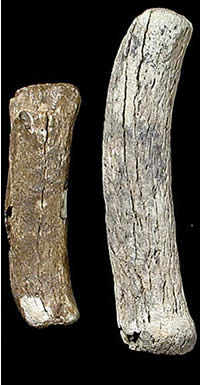
Antler tine tools such as these were
used over time for making chipped stone tools and other
purposes.
|
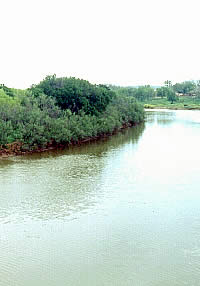
The deep Clear Fork of the Brazos
River. Situated at the river's juncture with the Salt
Fork, the Harrell site has been effected by both undercutting
and flooding.
|
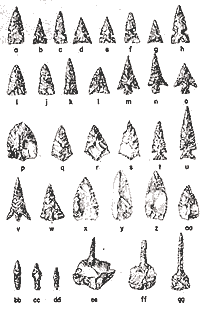
Tools, arrow points, and performs
from the Harrell site, as illustrated in Krieger's Culture
Complexes and Chronology in Northern Texas, 1946.
|
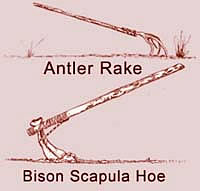
As they took up farming, Plains groups
used tools made from bone and antler, such as this bison
scapula hoe and antler rake. (Figure redrawn by Lynet
Dagel from Gilbert L. Wilson, Agriculture of the Hidatsa
Indians, copyright 1983 by the South Dakota State Historical
Society. Used with permission.)
|
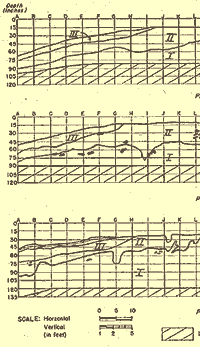
Krieger's stratigraphic profiles
of Excavation 3, showing the layer of dark midden earth
(II) and underlying reddish sandy clay (I). Because
earlier artifacts such as dart points were found with
later arrow points and pottery, Krieger incorrectly
concluded that the older types continued to be used
by later peoples. Profile from Krieger, 1946.
|
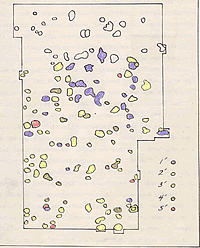
Map of hearths in the Excavation
3 area. As shown, their depths ranged from 1 to 5 feet
below surface. Map from Hughes, 1942.
|
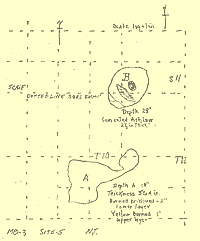
A rough field sketch of two unusual
features of fire-baked clay. Fox noted twig and grass
impressions in the lower feature that he thought might
represent wattle work. What the oval depressions within
the layer of cemented ash in the upper feature represent
is unknown.
|
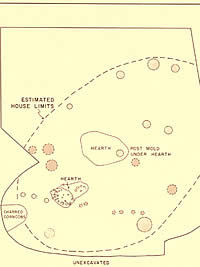
A Henrietta focus house pattern recorded
at the Fish Creek site in Cooke County, Texas. Post
holes appear to form an oval shape and surround interior
hearths and cache pits. Map adapted from Lorraine, 1969.
|
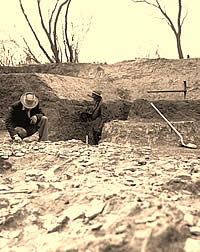
An archeologist examines a feature
on the southwest edge of the "Great Midden."
Photo from TARL Archives.
|
|